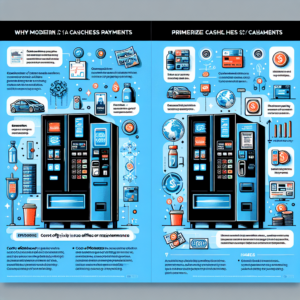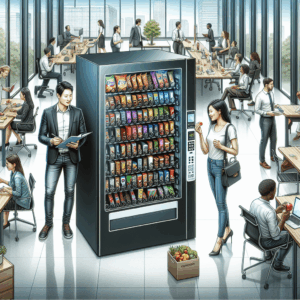Understanding Inventory Costs
Inventory Expenses You Might Be Overlooking
When we think about vending, the initial thought might be about the profits from those joyful little snacks and drinks. But let me tell ya, there’s another side of the coin – inventory costs. In my years of dealing with vending setups, I quickly learned that these inventory costs can sneak up on you. It’s not just about purchasing the stock; it’s about storing, maintaining, and eventually getting rid of excess items.
One expense area to consider is storage. Often, people underestimate the cost of keeping the products in a condition that’s ready to sell. Depending on what you’re vending, your products might need climate control or other specific conditions to stay fresh.
Additionally, managing stock levels can require time and resources. I’ve personally seen organizers underestimate the time it takes to conduct inventory checks, re-order products, and manage all the data. Just remember, time is money, and all those minutes add up.
Balancing Stock and Sales
Alright, let’s get real. Striking the right balance between stock and sales is a bit like walking on a tightrope – it’s tricky but absolutely crucial. I’ve juggled this balance for years and learned that you can’t just rely on gut instinct. You gotta look at the data.
A common rookie mistake is focusing only on frequently running out of stock, leading people to overstock. While it seems logical to avoid the dreaded ’empty’ situation, too much stock leads to its own problems. Instead, track sales patterns and adjust accordingly.
Being proactive rather than reactive is key. Knowing when certain products peak in sales can prevent overstocking due to panic-orders. This lesson has proven invaluable in every successful vending setup I’ve managed.
Tracking Inventory Efficiency
If you ain’t tracking, you’re slacking! In my experience, tracking inventory efficiency is not just a good idea – it’s a necessity. The tools you choose to track your inventory can radically change how effectively you manage stock levels.
Consider investing in inventory management software that keeps you up to date. It’s not just a chore; it’s a pathway to improve your operations. Real-time updates can help you make informed decisions that prevent overstock.
It’s also wise to review the data periodically. Look back at what’s working and what’s causing bottlenecks. You’ll start to notice patterns you can correct quickly. This iterative process is what turns a good setup into a great one.
The Perils of Excess Stock
Storage Challenges with Overstocking
Let me share a story about a friend who learned the hard way about overstocking. The vending setup looked great at first, with a full machine of goodies ready for the buying. But soon enough, storage became a nightmare. What do you do with all that extra stock when it doesn’t fit in the vending machine anymore?
Space is money, especially if you’re renting warehouse or storage space. When excess stock accumulates, you’re burning cash without seeing returns. This hidden cost can be a significant drain on your vending business.
Space management isn’t just about having more room. It’s about organizing efficiently, using vertical space, and making sure everything is easily accessible. If not managed well, you end up with a clutter of misplaced goods, leading to even more expense and stress with expired products.
Financial Implications
If you’ve ever found yourself buying in bulk to save a little here and there, listen up! While bulk purchases seem cost-effective at first glance, they can seriously harm if the items aren’t selling as planned. It comes down to a simple realization: unsold stock equals tied-up capital.
Every dollar that you’ve put into non-moving inventory is a dollar that isn’t working for you. This cash could be better spent elsewhere—be it new products, maintenance, or even marketing. Learning to optimize your stock turns these leftover items into active resources.
From my work with vendors, flexibility is vital. If possible, consider vendor agreements that allow product returns or exchanges on slow movers. It is always better to negotiate smarter deals than deal with excess inventory.
Pricing and Discount Strategies
We’ve all had products that just don’t sell. It happens. But having the right strategy can turn even unwanted stock into an opportunity. History has shown me that discounts and strategic pricing can move stock faster than you’d think.
Running occasional promotions isn’t just about slashing prices. It can also refresh interest in older items. This can be particularly useful for items you’d rather not see collecting dust on your shelf or in storage.
Partnering with others in your business can also open up avenues for clearing out inventory. Collaborations, joint sales, or bundles with high-performing items can give slow-moving products a new lease on life.
Impact on Product Freshness
Understanding Shelf Life and Spoilage
There was a time I didn’t pay close attention to a product’s shelf life. Boy, did I learn quickly! Nothing’s more embarrassing than a customer buying expired products. That not just ruins your sales; it damages your reputation.
Each product has its own timeline before spoilage sets in. If you overstock, you risk not moving the product quickly enough, wasting your investment. Paying attention to shelf life requires constant vigilance and effort.
To fight spoilage, it’s essential to rotate stock frequently, so older items are sold first. I’ve found that simple strategies like label checking and FIFO (First In, First Out) can save a lot of potential headaches and money losses.
Customer Satisfaction
Nobody wants to buy a stale snack or a soda that’s been in the machine forever. Believe it or not, those little details matter. People may not always mention it, but freshness impacts their buying decision.
In the long run, the quality of your products reflects directly on your brand’s image. It’s important to ensure freshness to guarantee that customers come back for more.
Going the extra mile by ensuring that products are rotated out frequently and are within their prime consumption range improves the customer’s experience. Happy customers usually mean busy vending machines.
Maintaining Product Variety
The array of choice in a vending machine plays a significant role in how appealing it is. Simplifying your stock might sound tempting when dealing with excess inventory, but don’t fall into that trap. The right variety keeps customers interested and coming back.
A varied offering also allows you to cater to diverse tastes without overstocking any one product too heavily. It’s this balance that keeps your vending venture flourishing.
A trick I’ve picked up is to replace slow movers with new or trendy options periodically. It spices things up and prevents the machine from turning stale, both literally and figuratively.
Strategies to Optimize Stock Levels
Utilizing Data for Better Decisions
You’ve heard me talk about data before, but I can’t stress enough how much it plays a role in optimizing stock levels. Real-time analytics can be magic in your hands if you know what to look for.
From tracking bestsellers to identifying slow movers, data gives you reliable insights that help you manage stock more effectively. It’s less about guessing and more about anticipating needs and trends.
Almost like your personal vending crystal ball, using software to harness real-time data has saved me headaches and boosted my bottom line many times over. Don’t sleep on this; it’s the future!
Smart Purchasing Techniques
If you’re not purchasing smart, you’re playing a tough game. Economically savvy purchasing isn’t about going cheap; it’s about maximizing value. Collaborating directly with suppliers has given me great advantages—don’t be afraid to ask for better terms.
One technique I recommend is adjusting purchases based on seasonal trends. There’s often a summer product rush, and winter favorites emerge when it gets cold outside. Aligning your purchases with seasonal preferences ensures you aren’t left with stockpile issues.
Remember, what’s good for one setup might not work for another. Tailoring your purchasing strategy to match the unique demands of your vending machine’s location maximizes success.
Implementing Feedback Loops
Want to get better? Listen up! Customer feedback is your best teacher. Over the years, I learned that the people using your machines can offer the best insights into what works and what doesn’t.
Encouragement can be facilitated through simple things like surveys or QR codes, allowing them to have a say in what’s offered. It’s a win-win; they get what they want, and you lower the risk of overstocking unwanted items.
It’s not just about listening but also acting on the information. The more you tune your business to your customers’ wants and needs, the more prosperous your vending setup will become.
FAQ
-
What are common pitfalls in overstocking vending setups?
Common pitfalls include financial burdens from storing unsold stock, inventory beyond machine capacity, reduced product freshness, and tied-up capital that could be used elsewhere.
-
How can inventory software help with stock management?
Inventory management software assists with real-time data tracking, making it easier to understand sales trends and adjust stock levels accordingly, thus reducing the chances of overstocking.
-
What strategies can improve customer satisfaction with vending machines?
Ensuring product freshness, maintaining a variety of choices, and using rotating stock strategies like FIFO help keep customers happy and machines more appealing.
-
How important is supplier collaboration in vending?
Collaborating with suppliers can be invaluable. It allows for better purchasing terms, ensures timely delivery, and could offer flexibility with product exchanges or returns of unsold stock.



